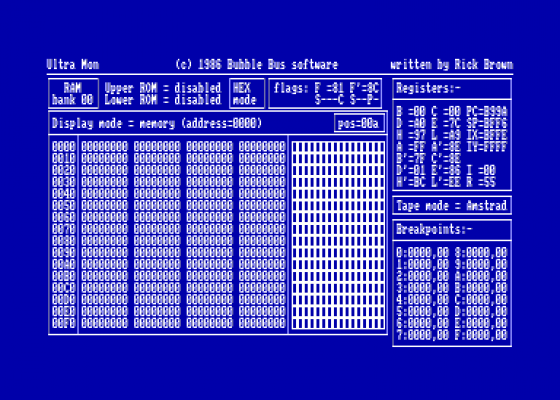
Amstrad Computer User
 1st August 1987
1st August 1987
Categories: Review: Software
Author: Dr. Garvanovic
Publisher: Bubble Bus Software
Machine: Amstrad CPC464
Published in Amstrad Computer User #33
A monitor is not a box like a TV screen - well, it is sometimes. But it can also be a program which is used for looking at the insides of other programs. Ultramon is a new monitor from Bubble Bus. Dr. Garavanovic offers his "prog" nosis hohoho...
Ultramon
Every now and then, the Ed will send me a piece of software with the aim of making my job just a little easier. Having already seen, and forgotten, quite a few programs, I don't relish the thought of having a look at another one.
Fortunately, Ultramon was an exception. The modest packaging gives the impression of a very unprofessional package, but looks can, and do, deceive. When run Ultramon greets you with a screen full of numbers and figures, and a very full 80 column screen it is too.
A quick look through the small (but well written), manual informs you of its many wonders. These include the usual move, disassemble and edit memory commands and a few rather special extras.
One command that isn't present though is a byte search. This omission, especially for hackers, is quite major: I can't have those 3E,3 (LDA, three lives in a game) sequences avoiding me, can I? The special commands, especially those connected with accessing the disc drive, more than make up for any inconvenience caused though.
Ultramon really excels when it comes to the little extras that are not generally found in other monitors. These include disc formatting aid editing, and the Spectrum tape routines - more of those later.
As well as allowing you to format using the standard DATA, SYSTEM and IBM systems, it will also let you customise the format, which is handy for protecting discs. When you wish to edit a disc the sector your editing appears in the main window and it's treated as if it was a section of memory.
This also means that you're not directly editing the disc, but a buffer, so mistakes are not fatal.
Probably the most exciting features though are the Spectrum load and save routines. Imagine using an Amstrad, and discs, to load and hack, or just to examine some machine code written on the Spectrum. I will definitely be using this feature in the very near future.
To sum up this rather brief review. I wouldn't hesitate to recommend this to anyone, although the omission of that byte search command is a bit of a drawback. This package isn't really for the faint-hearted, as it can be a bit hard going.
The manual is small, and think an example of each command might have helped the inexperienced.
One interesting thought though is of the size of the monitor: It's roughly 16K long, which means it's just crying out to be put on rom. After talking to Bubble Bus about this, there may be a rom version very soon, and that'll make me one very happy hacker.


